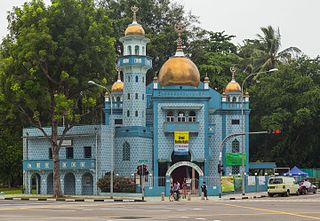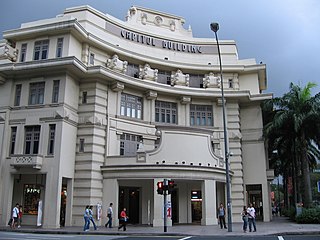Related Research Articles

The Economic Development Board (EDB) is a statutory board under the Ministry of Trade and Industry of the Government of Singapore that plans and executes strategies to sustain Singapore as a leading global hub for business and investment.


Clifford Pier was a former pier located beside Collyer Quay at Marina Bay within the Downtown Core of the Central Area, Singapore. The pier, which opened in 1933, ceased operations in 2006.

Masjid Malabar or Malabar Muslim Jama-Ath Mosque, also known as Golden Dome Mosque; is Singapore's only Malabar Muslim mosque. The mosque is located at the junction of Victoria Street and Jalan Sultan in the Kampong Glam district, in the Rochor Planning Area within the Central Area. The mosque is built on the Sultan Mosque style with traditional blue and white lapis lazuli tile facade. The mosque was nicknamed as little cousin of the Sultan Mosque, because of similar golden domes.

The Maghain Aboth Synagogue is a synagogue in Singapore. It is located at 24/26 Waterloo Street in Rochor, within the Central Area at Singapore's central business district. Constructed in 1878, it is the oldest and largest Jewish synagogue in Southeast Asia and the second largest in Asia itself, outside of Israel.

The Singapore Conference Hall is a multipurpose building located in the heart of the financial district of Shenton Way in Downtown Core of Singapore. The first building to be constructed along Shenton Way, it was a place for conferences and exhibitions in the 1960s and 1970s. Today, it is refurbished and modernised into a concert hall, home to the Singapore Chinese Orchestra since 2001. Completed in 1965 at a cost of S$4 million at that time, it was an example of the nation's urban architecture then. The building is situated on a three-acre site at the junction of Shenton Way and Maxwell Road.

Capitol Building, formerly Shaws Building and Namazie Mansions, is a historic building at the junction of North Bridge Road and Stamford Road in the Downtown Core of Singapore. The building had since redeveloped along with adjoined Stamford House and both were reopened as a hotel The Capitol Kempinski Hotel Singapore in October 2018.

111 Somerset is a high-rise commercial building and shopping mall in Orchard, Singapore. The building was first known as Public Utilities Board Building until 1995, and was later known as Singapore Power Building until 2008 when acquired by YTL Corporation Pacific Star. It used to house the headquarters of SP Group, until it shifted to its current site at Kallang.

The Fullerton Hotel Singapore is a five-star luxury hotel located near the mouth of the Singapore River, in the Downtown Core of the Central Area, Singapore. It was originally known as the Fullerton Building, and also as the General Post Office Building. The address is 1 Fullerton Square. The Fullerton Building was named after Robert Fullerton, the first Governor of the Straits Settlements (1826–1829). Commissioned in 1924 as part of the British colony's centennial celebrations, the building was designed as an office building by Major P.H. Keys of Keys & Dowdeswell, a Shanghai firm of architects, which won the project through an architectural design competition. The architectural firm also designed the Capitol Theatre, its adjoined Capitol Building and the Singapore General Hospital. In 2015, it is gazetted as a national monument of Singapore.
Swan & Maclaren Architects is a Singaporean architectural and industrial design firm. One of the oldest architectural firms in the country, it was formerly known as Swan & Maclaren and Swan & Lermit, and was one of the most prominent architectural firms in Singapore when it was a crown colony during the early 20th century. The firm has designed numerous iconic heritage buildings in Singapore as well as Malaysia.

Yue Hwa Building is a historic building located at the junction of Eu Tong Sen Street and Upper Cross Street in Chinatown, Singapore, next to Chinatown MRT station. Built by Swan and Maclaren in 1927, it was then the tallest building in Chinatown and was known as Nam Tin Building (南天大厦), owned by Lum Chang Holdings. The building housed the six-storey Great Southern Hotel, along with a few shops and cabarets that were popular among Chinese travellers. In 1993, Lum Chang Holdings sold the building to Hong Kong businessman Yu Kwok Chun, who converted it to the first Yue Hwa Chinese Products department store in Singapore in 1994. The renovation process, which conserved the exterior while adding features such as an atrium and waterfall to the interior, won the building the Architectural Heritage Award by the Urban Redevelopment Authority in 1997.

Voco Orchard Singapore is a voco hotel in located at Orchard Road, Singapore. It is the first voco branded hotel by InterContinental Hotels Group in Southeast Asia
DP Architects Pte Ltd is a Singaporean multinational architectural industrial design firm. It started as Design Partnership in 1967 and was incorporated as a private limited company in 1993. It is a multi-disciplinary design consultancy. It is one of the largest architectural practices in the world.

Berthel Michael Iversen was a Danish architect active in Malaysia, and the founder of Iversen, van Sitteren & Partners. Most of his works were in Malaya and Singapore. He designed a large number of buildings in his Malayan home town, Ipoh. He eventually had offices in Ipoh, Penang, Kuala Lumpur, and Singapore. He did a large number of cinemas throughout Malaysia for the Shaw Brothers, a film production company which was the precursor to the Shaw Organization. Iversen's early works are sometimes described as Art Deco, but after World War II, his buildings became increasingly modern, and he became one of Southeast Asia's most important modernists. His works were an integral part economically and symbolically for the newly developed countries of Malaysia and Singapore.

Susan Hendrik 'Henk' van Sitteren (1904–1968) was a Dutch architect in Singapore and Malaysia. His career began when he came to Singapore and landed a position in Keys & Dowdeswell, then a major international architecture firm. It was during this time that Van Sitteren met his future partner, architect Berthel Michael Iversen. The two would later establish Iversen & Van Sitteren Partners - with branches in Ipoh, Penang, Kuala Lumpur & Singapore. The firm was one of the most important in Southeast Asia for establishing a foothold for international style modernism.

Dover Court International School is an international school in Singapore. Founded in 1972, the school delivers the English National Curriculum and International Baccalaureate Diploma Program to 1850 students between the ages of 3 and 18. Over 60 nationalities are represented in the school, with the majority of teachers coming from the United Kingdom. In 2015, Dover Court International School registered with the Committee for Private Education of Singapore and since April 2014 has been part of the Nord Anglia Education group of schools. It is a member of the Federation of British International Schools in Asia (FOBISIA), and accredited by the Council of International Schools (CIS) and the Western Association of Schools and Colleges (WASC).

Istana Tyersall is a demolished historical palace that used to be in the former Tyersall Park bound by Holland Road and Tyersall Road near the Singapore Botanic Gardens in Singapore. The land it was formerly built on is currently restricted from the public.

The Fullerton Waterboat House, originally known as the Water House, is a historic water supply house formerly used to supply fresh water to incoming ships in Singapore. The former Water House was gazetted for conservation in 2002 and has since reopened as a restaurant.

Capitol Theatre, briefly Kyo-Ei Gekijo, is a historic cinema and theatre located in Singapore. It was adjoined to four-storey building known as the Capitol Building. The Capitol Theatre was considered one of Singapore's finest theatres in the 1930s during that time.

Shaw Tower, also sometimes referred to as Shaw Towers, is a defunct high-rise commercial building located on Beach Road in Singapore. At the time of its completion in 1975, the tower housed the largest cinema in Singapore.
References
- ↑ "Legacy". The Straits Times. 6 June 2000.
- ↑ "New Firm of Architects". The Straits Times. 20 May 1927.
- ↑ "Tenders". The Straits Times. 10 August 1931.
- ↑ Guggenheim, Michael; Söderström, Ola (1 December 2014). Re-shaping Cities : How Global Mobility Transforms Architecture and Urban Form. ISBN 9781135189099.
- ↑ "Perak Turf Club's New Grandstand". The Singapore Free Press and Mercantile Advertiser. 3 October 1929.
- ↑ "Singapore's New Building". The Straits Times. 9 October 1929.
- ↑ "The K.P.M. Building". The Singapore Free Press and Mercantile Advertiser. 7 November 1930.
Bibliography
- http://eresources.nlb.gov.sg/newspapers/Digitised/SearchResults.aspx?keyword=keys%20and%20dowdeswell
- http://eresources.nlb.gov.sg/infopedia/articles/SIP_1087_2011-01-21.html
- http://www.ipohworld.org/
- http://www.ytlhotels.com/publications/ytl-life/YTL_Life_19.pdf
- http://www.yoursingapore.com/see-do-singapore/architecture/historical/capitol-building-singapore.html